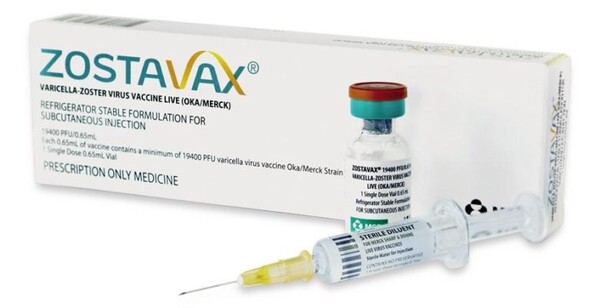The Ministry of Food and Drug Safety (MFDS) recently said MSD Korea would discontinue the supply of Zostavax, the live attenuated shingles vaccine.
MSD Korea confirmed the MFDS’ announcement, stating that Zostavax will be available until July 31, with the final discontinuation date set for Sept. 30.
Shingles is caused when the varicella-zoster virus (VZV), which causes chickenpox, becomes reactivated. When specific cellular immunity to VZV decreases below a certain threshold due to aging or weakened immunity, the body cannot overcome the reactivation of the virus, leading to shingles.

Zostavax, first approved in April 2019 in Korea, is used to prevent shingles in adults aged 50 and older.
“The decision is unrelated to the product's quality or safety but is a response to decreased clinical demand and the availability of alternative vaccines introduced in the Korean market,” a company spokesperson told Korea Biomedical Review. “Over the past 15 years, Zostavax has played a significant role in preventing shingles among Koreans.”
The company will ensure that the remaining Zostavax supply in the domestic market is managed and distributed smoothly, she said.
“As we withdraw from the market, the focus will shift to developing new medications and vaccines to meet other critical medical needs,” she added.
The discontinuation of Zostavax leaves SK bioscience’s SKYZoster and GSK’s Shingrix as the remaining shingles vaccines in Korea. Industry experts predict that Shingrix will benefit most from Zostavax’s exit.
Shingrix, a recombinant inactive vaccine, is distinguished by its higher efficacy and suitability for immunocompromised individuals, despite requiring two doses and being more expensive. Shingrix boasts a prevention rate of up to 97.2 percent for those aged 50 and older, outperforming Zostavax’s 69.8 percent and SKYZoster, which proved non-inferiority to Zostavax.
SKYZoster still remains a more cost-effective option, with single-dose administration costing between 100,000 and 150,000 won ($72-109) compared to Shingrix’s two-dose regimen costing 200,000 to 250,000 won per dose.
Such a low price was reflected in the sales figures from last year with SKYZoster recording first place in the shingles vaccine market by doses given with 310,159 doses, compared to Shingrix’s 224,334 doses and Zostavax’s 223,842 doses.
Despite such sales figures, industry watchers expect that Shingrix will reap more benefits as, unlike live vaccines such as SKYZoster, inactivated vaccines use viruses or bacteria that have been killed before use, making Shingrix the only shingles vaccine available for immunocompromised individuals or cancer patients.
Shingrix has already dominated the shingles vaccine market overseas. In 2018, the U.S. Advisory Committee on Immunization Practices, under the Centers for Disease Control and Prevention (CDC), excluded live vaccines from their recommendations for shingles vaccine.
The U.K. followed suit in September 2023, recommending recombinant vaccines for all 65-year-olds and replacing Zostavax with Shingrix in its national shingles program. In Korea, the Korean Society of Infectious Diseases updated its guidelines in 2023, prioritizing inactive vaccines over live vaccines for their prolonged efficacy.
“Given that most developed countries are prioritizing Shingrix, it is expected that Korea will follow a similar path,” a dermatologist running a clinic in Gyeonggi Province told Korea Biomedical Review.
Related articles
- Why is Shingrix, the only shingles vaccine available for cancer patients, so painful?
- GSK’s Shingrix tops singles vaccine sales in Korea in 2023: IQVIA data
- GSK's Shingrix vaccine linked to higher risk of ‘ophthalmic zoster’ recurrence: study
- ‘Shingrix offers shingles preventing opportunity for rheumatology patients’
- [Reporter's Notebook] The unfulfilled promise of expanding national immunization program
- Efficacy study of Genematrix’s new shingles vaccine candidate published in ‘VIROLOGY’
- ‘Shingrix shifted the paradigm of preventing shingles in people with IBD’
- GC Biopharma’s US affiliate Curevo pulls in $110 mil. to challenge GSK’s Shingles vaccine

